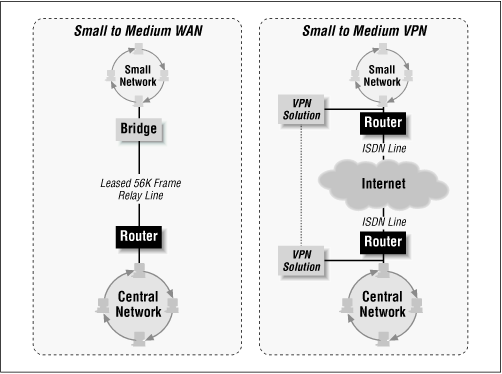VPN Versus WAN
This section illustrates how to use a VPN to solve WAN issues, and the various comparison points between the two. In sticking with our six generic criteria, we explore the small to medium VPN/WAN and the large VPN/WAN in turn, as each has its own specific issues.
Small to Medium Solutions
While this is a broad topic, we will define a small to medium network as anything under 100 nodes (including the central network). Figure 3-4 compares a typical small to medium WAN to its VPN counterpart. Both scenarios include a small remote network that needs to connect to a central network resource.

Figure 3-4. Leased-line solution versus virtual private network
Telco
The WAN connection could use an ISDN line if the remote network is within the local calling area of the main office. If the remote office is out of this area, a leased 56K bps frame relay line would be the best bet. The big difference is that an ISDN line usually does not incur per-minute charges if the call is local, but would rack up long distance charges otherwise. However, some calling areas do incur per-minute charges for local ISDN calls. A frame relay line typically has a flat rate per-month charge, and is generally more expensive than an ISDN line, especially considering any mileage charges associated with the line.
ISDN offers more bandwidth (up to 128Kbps with a single basic rate ISDN line). Two 56Kbps leased ...
Get Virtual Private Networks, Second Edition now with the O’Reilly learning platform.
O’Reilly members experience books, live events, courses curated by job role, and more from O’Reilly and nearly 200 top publishers.

